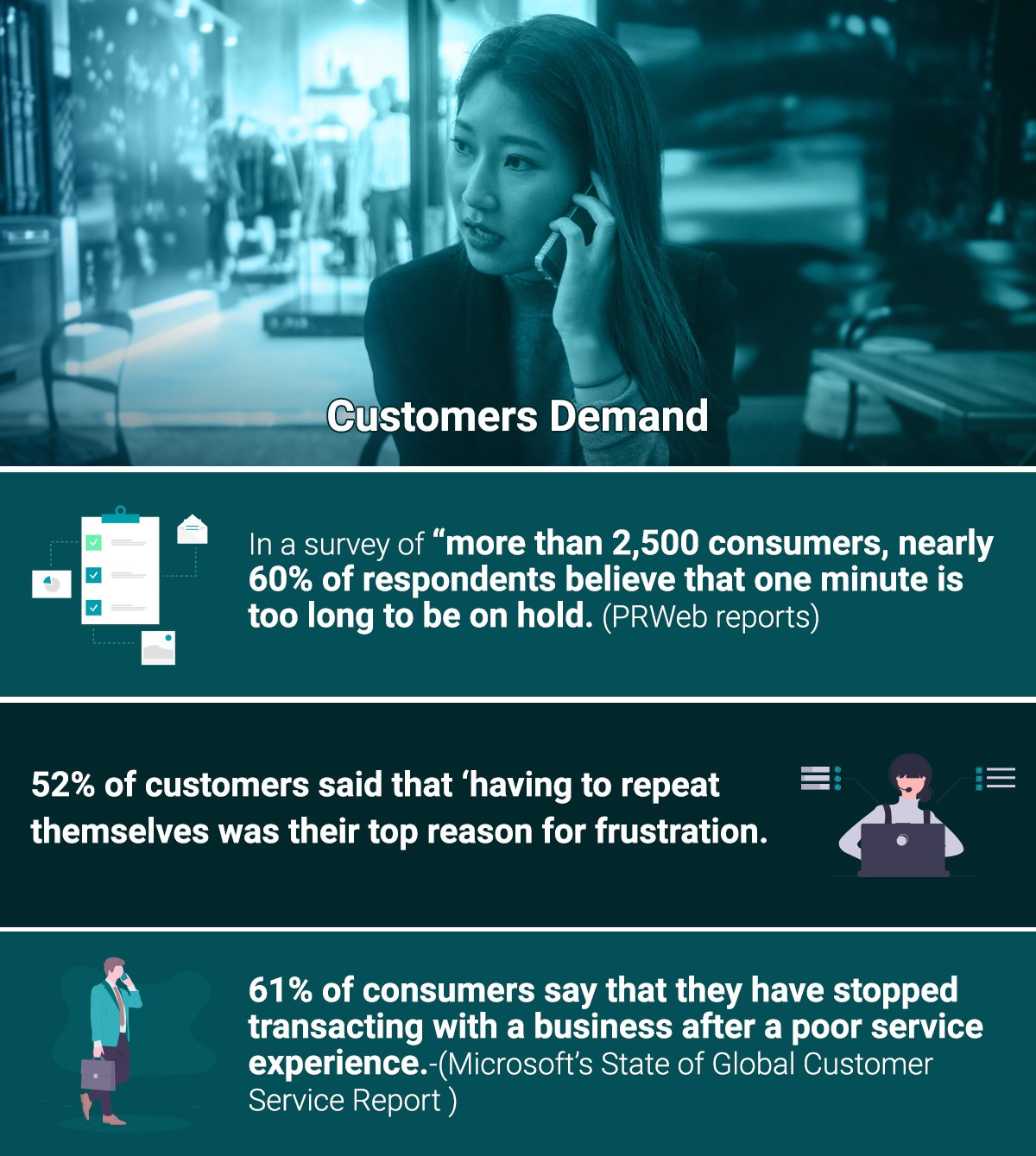Apart from being a rather confusing year, 2020 a decade since the Google Assistant came to exist as an application, which was later incorporated into the software giant’s operating system for phones and other Google products. Today, the market is filled with voice-enabled virtual digital assistants like Amazon’s Alexa, Microsoft’s Cortana, Apple’s Siri, etc. All of them give us the luxury of owning an assistant who listens, anticipates your every need, and takes action when necessary. What if the same luxury is given to the employees of an enterprise?
According to a Mckinsey report, about 10 hours per week on average is spent by an employee for searching and gathering information. Today’s typical enterprise still has 100’s of internal apps and 10’s of huge enterprise systems, which are used by employees to communicate and for productivity gains.
The report suggests that it is an opportune time for enterprises to get on board with digital transformation in order to remain in the market. One of the key benefits with intelligent virtual assistants is it enables businesses to essentially grow their workforce without having to hire more employees. This not only reduces costs, but creates a better customer experience, and frees up employees to dedicate time to other important tasks and businesses for the company.
However, this has sparked a conversation where many employers still seem hesitant about implementing either a chatbot or an intelligent virtual assistant. From the offset, it appears that one is not sure if customers are happy to deal with machines instead of humans. But data can form the basis of a change. Here is a look at some statistics.
For easy consumption, we’ve broken this blog into different segments. The segments are as follows:
1. Virtual Assistants/Chatbots Adoption Statistics
2. Virtual Assistants/Chatbots Adoption Challenges
3. Virtual Assistants/Chatbots Trends
4. Customers Demand
5. Virtual Assistants/Chatbots in Customer Support
6. The future of Virtual Assistants/Chatbots in Customer Support
Read More: Why a Low-code/No-code Platform is Ideal for Driving Greater Adoption of Virtual Assistants |
Virtual Assistants/Chatbots Adoption Statistics
- According to Chatbots Magazine, businesses can reduce customer service costs by up to 30% by implementing conversational solutions like virtual agents and chatbots. (Chatbots Magazine)
- Gartner suggests that AI solutions will recover more than 6.2 billion hours in employee productivity going forward. (Gartner)
- By 2025, collaborative customer service organizations that adopt digital co-working principles will achieve greater customer satisfaction and employee engagement than those with siloed business operations. (Gartner: Predicts 2020: CRM Customer Service and Support, January 2020)
- By 2025, customer service organizations that embed AI in their multichannel customer engagement platforms will elevate operational efficiency by 25%. (Gartner: 2019 Strategic Roadmap for Customer Service and Support Technologies, May 2019)
- Chatbots will generate over $8 billion in global savings by 2022. (Juniper Research)
- Messaging apps will have 5 billion MAU’s (monthly active users) in 2020 – about 60% of the world population. (HubSpot)
- The Global chatbot market will be valued at $1.3 billion in 2024. (Global Market Insights)
- C-level executives start 41% of online chat conversations with businesses. (Drift)
- By 2023, more than 60% of all customer service engagements will be delivered via digital and web self-serve channels, up from 23% in 2019.
Virtual Assistants/Chatbots Adoption Challenges
- 64% of executives say that user adoption hesitancy is the main reason why they don’t intend to implement chatbots. (Accenture)
Virtual Assistants/Chatbots Trends
- In 2022, the banking industry could see the success rate of bot interactions reach over 90%. (Juniper Research)
- Gartner suggests that AI solutions will recover more than 6.2 billion hours in employee productivity going forward.
- 85% of customer support interactions will be performed by a chatbot by 2020. (Gartner)
- 80% Percentage of organizations looking to implement chatbots by 2020. (CCW Digital)
- By 2021, $4.5 billion will be invested in chatbot technology. (Opus Research)
- Gartner predicts that by 2021, over 50% of enterprise companies (like Google, IBM and Facebook) will spend more money each year on chatbots than mobile apps. (Gartner)
Read More: Conversational AI: Top 20 Trends for 2020 |
Customers Demand
- In a survey of “more than 2,500 consumers, nearly 60% of respondents believe that one minute is too long to be on hold. (PRWeb reports)
- In addition, 32.3% of consumers believe that customer service departments should be answering immediately—with no hold time.” (PRWeb Reports)
- 61% of consumers say that they have stopped transacting with a business after a poor service experience. (Microsoft’s State of Global Customer Service Report )
- 29% of the top 100 Android apps were able to answer even the most basic question. Conversely, we did not even hear back from 71% of apps. Moreover, it took an average of 25 hours for companies to send back a response to a very simple yes/no question. (Forbes)
- “40% of approximately 3,000 consumers in a global survey said they prefer self-service to human contact for their future contact with companies.” (SessionCam)
- 60% of customers will abandon a call after waiting too long on a call, and 62% of customers are frustrated by businesses that only offer one or two ways to get in touch with them. (Velaro)
- Almost two-thirds said they would wait two minutes or less and 13% said that "no wait time is acceptable". ICMI(International Customer Management Institute)
Read More: Reimagine Your Contact Center Experience With SmartAssist.ai |
Virtual Assistants/Chatbots in Customer Support
- 37% of users say they would use a chatbot to get timely responses in an emergency. (Drift)
- 27% of consumers were unsure if the last customer support interaction they had was with a real person or a chatbot. (PwC)
- 35% of people say they would use a chatbot for a complaint, a problem, or to get explanations. (Drift)
- 34% of retail customers would be comfortable speaking with customer service through an AI chatbot instead of live chat. (Statista)
- 34% of online buyers said they would prefer to answer questions from AI via chatbots or virtual assistants. (Chatbots Magazine)
- Chatbots can help brands save up to 30% on their customer support costs.(IBM)
Read More: AI is Now Firmly Part of Every Call Center’s Strategy for Growth |
The future of Virtual Assistants/Chatbots in Customer Support
- It’s expected that by 2022, up to 80% of common customer service inquiries will be deflected to chatbots, decreasing banking interaction costs by an average of 70 cents per interaction. (Juniper Research)
- By 2023, 30% of customer service organizations will deliver proactive customer services by using AI-enabled process orchestration and continuous intelligence. (Gartner)
- The chatbot market size is projected to grow from $2.6 billion in 2019 to $9.4 billion by 2024 at a compound annual growth rate (CAGR) of 29.7%. (Business Insider)
- By 2023, 35% of the customer service workload will be done through crowdsourcing, telecommuting, work-at-home agents and gig-economy workers, up from 5% in 2017. (Gartner)
The future of adoption of Virtual assistants/chatbots in customer service management looks brighter. But that doesn’t mean that human conversations are losing interest among the customers. It’s just AI & NLP powered virtual assistants that save us costs, time and resources while improving and personalizing the customer service experience.
|
Start your organization's virtual assistant journey now  |
Quickly build omnichannel and multi-lingual bots on the Kore platform |













